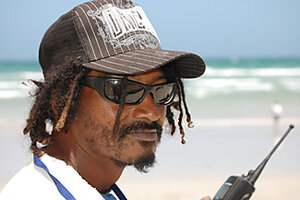Meet South Africa's top shark spotter
Patrick Davids left behind a life plagued by alcoholism and drug addiction to keep swimmers and surfers safe along one of the world's most perilous coastlines.

Keeping a Watchful eye: Patrick Davids manages shark spotters on nine South African beaches.
Ian Evans
Cape Town, South Africa
Like a predator stalking his prey, Patrick Davids's eyes rarely stray from the choppy green sea, and his radio is always at the ready.
While the assortment of sunbathers, swimmers, and surfers may not know his name, they know what he does and that one day they may owe him their lives.
Mr. Davids, or "Rasta" as he is better known, is a shark spotter who helped set up one of the world's only shark-monitoring units along beaches in Cape Town, South Africa.
From a cramped beach hut, Davids has helped build up a network of full-time shark spotters on nine beaches, watching over one of the world's most shark-infested shorelines.
Nearly seven years ago, the former alcoholic and drug addict was chased out of his Cape Town suburb by vengeful gangsters after falling into debt from his drug habits. He fled to nearby Muizenberg Beach, where he scratched out a living as a car guard.
"My parents didn't know where I was for two years – and they couldn't know, because the gangsters were after me," says Davids. "I was in big trouble, and I was drinking and smoking too much. I was homeless and looking in [garbage] bins for food."
But after two years, his car-guarding career was about to change. In April 2004, a local teen, J.P. Andrews, was attacked by a great white shark while surfing off Muizenberg. Doctors pronounced him dead on the beach – but his life was saved, though he lost his right leg.
The effect on local businesses was profound as people stayed out of the water and off the beaches.
Start of Davids's shark-spotting 'career'
Two weeks after the attack, a local surfer gave Davids some binoculars and asked him to scale a nearby mountain to keep a lookout.
"If I saw a shark, I was to phone a local surf shop, who'd [send someone to] the beach and warn people to get out of the water," Davids says. "Some of the surfers and businesses would pay me."
Dressed in a white T-shirt with a shark emblazoned on the back, shorts, dark sunglasses, his dreadlocks sticking out under a well-worn cap, Davids now oversees a much larger operation.
Since 2004, staff numbers have grown to around 36 in the summer – 16 in winter – boosted by increased sponsorship, including an annual 1.5 million rand ($154,000) budget for the next four years from the City Council.
But while Davids is confident in his ability to protect people from sharks, he's not complacent.
The 'McDonald's of the sea'
Davids says it's not surprising that sharks visit the area. "There is Seal Island, which has 78,000 seals and a lot of baby seals that stray from their mothers," he says, pointing to a small outcrop in the bay. "There are penguins in [nearby] Simon's Town. Dolphins, yellowtail [a fish] and birds come here to breed – plenty of feeding opportunities. I call it the McDonald's of the sea.
"They've been coming here for millions of years, but now humans use the sea more and more: surfing, surfing with parachutes, swimming."
Davids is well-respected on the beach. Surfers and swimmers are given reassurance; beach bums nod and say hello.
In a country racked by poverty and crime, he's a welcome sight – even if in a previous life he stole to feed his habits.
But his main priority is spotting sharks. Officials at the local Save Our Seas Shark Center have tagged 78 great whites in False Bay that migrate to Australia and Mexico in the winter.
Center marine biologist Alison Kock, who also carries out research for Shark Spotters, says the network has been invaluable.
"When we had the attacks in 2004, it became critical for businesses and Cape Town," says Ms. Kock. "People didn't want to go in the water, they were scared. It's very difficult to change people's perceptions of the shark, but they're not the threat they think they are.
"That's why [Davids] and the spotters are terrific. Yes, they keep watch on shark movements but they also help educate people about great whites.
"[Davids] is absolutely fantastic – he almost owns the beach at Muizenberg. He's central to what happens, but also deals with general inquiries, safety, and people look out for him. People love him down there."
The shark spotters have assigned names for some of their more regular visitors: Charlize, a 4.5-meter-long female named after South African actress Charlize Theron; Speedy, who dives in the waves like a surfer; Nosey, who spends her time swimming in and out of shore; and Rosy, who has a roselike pattern on her dorsal fin.
Spotters work a five-hour morning or afternoon shift and get paid 90 rand ($9.25). They are equipped with whistles, binoculars, and foghorns, and are in constant touch via radio.
On the beach, the spotters employ four warning flags, including a white banner with the silhouette of a black shark warning swimmers to leave the ocean. Since helping set up the network, there have been 476 recorded sightings, but no attacks on humans.
"We try and minimize the risk of attack, but we can't say 100 percent there will never be another one," says Davids.
"There are more scary, two-legged sharks on land who come into your house.... I'd rather take my chances in the ocean than land," he adds, before his walkie-talkie crackles into life and he heads off along the shoreline.
